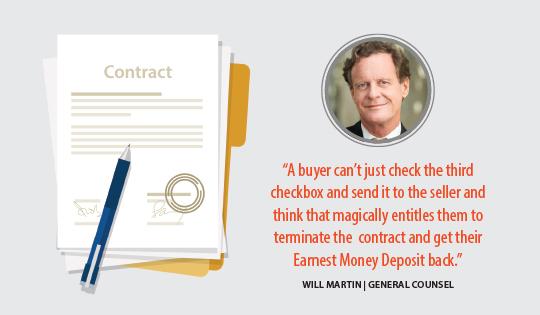Legal Talk: Form 350-T

A discussion on the buyer’s right to terminate a contract if the condition of the property changes
By Will Martin | General Counsel
Dear Forms Guy,
I’m confused about a change that was made this past July to the third checkbox in Form 350-T (“Notice to Seller That Buyer Is Exercising Their Unilateral Right To Terminate the Offer to Purchase and Contract (Form 2-T)). Can you help me?
Sincerely, Ray
Forms Guy: I’ll do my best, Ray. What’s troubling you?
Ray: Thanks, Forms Guy. In the old version of Form 350-T, the third checkbox gave the buyer the right to terminate the contract as a result of a fire or other casualty loss under paragraph 12 of the old version of the Offer to Purchase and Contract (Form 2-T). In the new version of Form 350-T, the third checkbox now gives the buyer the right to terminate the contract if the property “is not in substantially the same or better condition at Closing as on the date of this offer, reasonable wear and tear excepted.” Why was the wording in this checkbox changed? It seems that the new wording gives buyers an easy way to terminate a contract if they want out!
Forms Guy: Before I answer your question, I need to give you a little background.
Before July 1, 2019, the contract had two different paragraphs that addressed the effect of something happening to a property during the time after an offer was made, but before it closed. Paragraph 12 (“Risk of Loss”) addressed the effects of a fi re or other casualty taking place (for example, a hail storm that damages the roof and/or siding), while paragraph 11 (“Condition of Property at Closing”) addressed other things that might happen, such as the failure of a system (for example, an HVAC system that was in good working order on the date of an offer, but breaks down just before settlement).
There was confusion from time to time about whether a particular situation was covered under paragraph 11 or paragraph 12. Each paragraph worked a little differently, so let me explain.
Both paragraphs gave the buyer an “out” if the condition of the property changed in some material way after an offer but prior to closing. However, a buyer terminating under paragraph 11 was entitled to a refund of their Earnest Money Deposit, while a buyer terminating under paragraph 12 was entitled to a refund of their Earnest Money Deposit and their Due Diligence Fee. Also, under paragraph 11, it was clear that the appropriate time for determining whether the buyer had the right to terminate was at the time of closing. In contrast, under paragraph 12, it wasn’t entirely clear whether the buyer had the right to terminate at the time of the casualty loss or had to give the seller an opportunity up until the time of closing to fix the damage caused by the casualty.
The task force of REALTORS® and real property attorneys responsible for the content of the contract decided that there didn’t appear to be a compelling reason to distinguish fire and casualties from other kinds of events that cause the condition of a property to change while it is under contract. They agreed that it would be wise to combine paragraphs 11 and 12 into a single paragraph addressing the effect of a material change in the condition of the property after it goes under contract but before it closes. The task force’s recommendation to combine the two paragraphs into a single new paragraph 11 was approved and became effective July 1, 2019.
Ray: I appreciate the fascinating history lesson, but what does that have to with the change in Form 350-T?
Forms Guy: I’m getting there, Ray. The third checkbox in the old version of Form 350-T was designed for use by buyers who had elected to terminate the contract under old paragraph 12, that is, when a fire or other casualty loss destroyed or materially damaged the property before closing. As a result of the consolidation of paragraphs 11 and 12 into a single new paragraph, the wording in the third checkbox of Form 350-T needed to be changed to track the wording in the new paragraph 11.
Ray: Okay, I understand that the third checkbox in the old version of Form 350-T was there for buyers who wanted to terminate the contract under old paragraph 12. You said that a buyer also had the right to terminate under old paragraph 11 if something other than a casualty loss caused the condition of the property to change after an offer, but before closing. Why wasn’t there also a checkbox in Form 350-T for buyers who wanted to terminate under old paragraph 11?
Forms Guy: It was merely an oversight, Ray. My guess is that it was overlooked when Form 350-T was first created, and nobody ever noticed that it wasn’t there. It’s pretty rare for the condition of a property to change substantially by something other than a fire or other casualty.
Ray: Are you saying that a buyer always had the right to terminate the contract if the property was not in substantially the same or better condition at closing, and there just hasn’t been a checkbox in Form 350-T?
 Forms Guy: Yes, that is correct. The “new” wording in the third checkbox of Form 350-T isn’t really new at all. That wording has been in the contract for many years.
Forms Guy: Yes, that is correct. The “new” wording in the third checkbox of Form 350-T isn’t really new at all. That wording has been in the contract for many years.
Let’s get back to your concern that the third checkbox in the new version of Form 350-T might give a buyer an easy “out” of the contract. A buyer can’t just check the third checkbox and send it to the seller and think that magically entitles them to terminate the contract and get their Earnest Money Deposit back. They have to be able to demonstrate that the property is no longer in “substantially the same condition” as a result of something that happened after they made an offer on the property. Admittedly, reasonable minds may differ on whether or not the property is in substantially the same condition. Still, it is clear that the property doesn’t have to be in exactly the same condition and that relatively insubstantial changes would not support a buyer’s attempt to terminate the contract under paragraph 11.
Also, if something did take place that arguably put the property in something less than substantially the same condition, the buyer would have to give the seller a reasonable opportunity to return the property to the condition it was in before the buyer could terminate under paragraph 11. That’s because the buyer’s right to terminate under paragraph 11 is triggered by the property not being in substantially the same condition at closing. The seller would have the benefit of the 14-day permitted delay under paragraph 12 to make any necessary repairs.
A buyer who attempts to terminate a contract under paragraph 11 without having a demonstrable basis for doing so is running the risk that they are in breach of contract if they fail to close, which would entitle the seller to keep their Earnest Money Deposit.
Ray: Thanks for the explanation. I have another question. Let’s say something significant does happen to a property while it’s under contract, and the seller is unable or unwilling to restore the property to the condition it was in before the change took place. If the buyer elects to terminate the contract, why wouldn’t they also get their Due Diligence Fee back under new paragraph 11?
Forms Guy: Good question, Ray. I think the answer lies in understanding the difference between a breach of contract by the seller and the failure or non-fulfillment of a condition of the contract. If the seller breaches the contract, the buyer is entitled to recover damages the buyer has sustained on account of that breach. It’s clear under paragraph 8(n) of the contract that this would include any Due Diligence Fee and Due Diligence costs incurred by the buyer.
On the other hand, a “condition” of a contract (also called a “contingency”) is different. Think of a condition as a prerequisite to a party’s obligation to perform. If the prerequisite fails or is not satisfied, that party is legally excused from performing. But the failure or non-fulfillment of a condition is not considered a breach by the other party.
Remember that before the “Due Diligence Contract” was introduced in 2011, the contract contained many such conditions. Under the old contract, if the buyer was unable to obtain a loan or the property didn’t appraise, the buyer had the right to terminate the contract and get their Earnest Money Deposit back. However, the failure of either of those conditions wasn’t a breach of contract by the seller that entitled the buyer to recover anything other than their Earnest Money Deposit. The few conditions that remain today treat the non-fulfillment of a condition in this same way. For example, the buyer is only entitled to a refund of their Earnest Money Deposit under the FHA/VA Financing Addendum (Form 2A4-T) if the property doesn’t appraise, or under the Short Sale Addendum (Form 2A14-T) if the seller doesn’t get short sale approval from all lien holders.
Applying this distinction to new paragraph 11, if something happens to a property under contract that causes it to be in less than substantially the same condition as on the date of offer, and the seller does not restore the property to the condition it was in before the change took place, the buyer, at their option, is legally excused from having to complete the transaction. However, if the seller fails to restore the property to its previous condition, it is not a breach of contract, so the buyer is entitled to a refund of their Earnest Money Deposit but not of any Due Diligence Fee or Due Diligence costs. In combining paragraphs 11 and 12 of the old contract into a single paragraph, the Joint Forms Task Force concluded that this result was consistent with the way conditions work from a legal point-of-view and with the way they have been treated historically in the contract and its various addenda.
DID YOU KNOW?
NC REALTORS® have free, unlimited access to our Legal Hotline and lawyers with more than 30 years’ experience. Call 336-294-1415 or email legalhotline@ncrealtors.org with any questions regarding contracts, forms, fair housing, disclosure and more.

